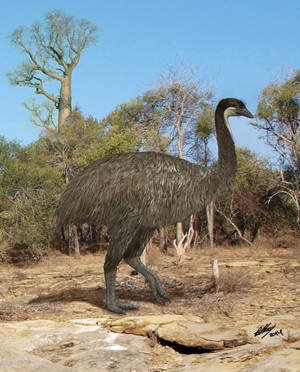 New research using ancient DNA has shattered the idea that New Zealand's iconic kiwi is a close relative of Australia’s emu. Instead, it turns out the kiwi has a close connection with a mysterious flightless bird that was the stuff of legends – the elephant bird, a 2.3m, 250kg giant from Madagascar. Pictured on the left is an image of what the elephant bird would have looked like before it died out (Brian Choo).
New research using ancient DNA has shattered the idea that New Zealand's iconic kiwi is a close relative of Australia’s emu. Instead, it turns out the kiwi has a close connection with a mysterious flightless bird that was the stuff of legends – the elephant bird, a 2.3m, 250kg giant from Madagascar. Pictured on the left is an image of what the elephant bird would have looked like before it died out (Brian Choo).
This research from the Australian Centre for Ancient DNA (ACAD) has solved a 150-year-old evolutionary mystery about the origins of the giant flightless ratite birds, a group that includes the kiwi, emu, cassowary, ostrich and rhea.
Ratites are all flightless and comparative giants (apart from the kiwi), and the group also includes large extinct birds, such as the moa and Madagascar’s elephant birds.
The centre’s director, evolutionary biologist Alan Cooper, says the enormous size of the elephant birds’ eggs is believed to be the inspiration for the Arabic mythological rukh of Sinbad fame. “A giant eagle-like bird capable of carrying off an elephant in its talons, hence the name.”
He says ratite birds have mystified evolutionary scientists since they were first encountered, as in many ways they appeared to be more like mammals than traditional birds. "Their primordial form, and presence only on the southern continents, quickly led to the idea that they were an ancient form of bird that survived only in the specialised role of giant herbivore."
The different ratite species were long thought to have formed as the flightless birds were isolated by the separation of the southern continents over the last 130 million years. However, ancient DNA extracted from bones of two elephant birds held by the Museum of New Zealand, Te Papa Tongarewa, has revealed a close genetic connection with the kiwi, despite the striking differences in geography, morphology and ecology between the two.
The findings also indicated that the ratite linages had spread via flying ancestors, rather than flightless birds being separated by continental drift. The study corrects Alan Cooper’s own previous research from the 1990s. He says it has taken this long to solve the puzzle because the elephant bird was the last of the ratites to be analysed and there was so little ancient DNA, that the work was only possible with the latest genomics technology.

